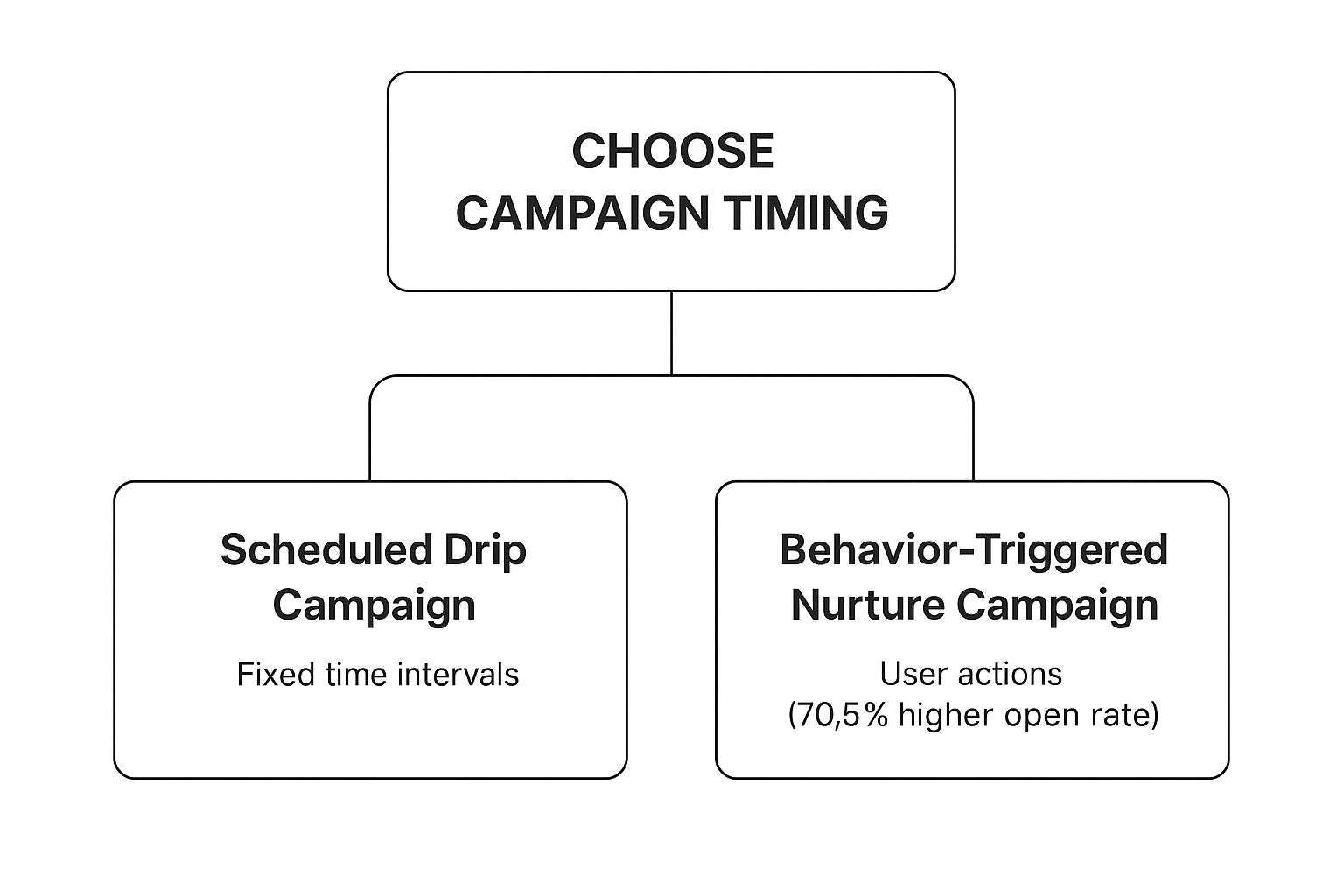Drip Campaign vs Nurture Campaign: 6 Key Differences
May 21, 2025

Understanding the Nuances: Drip vs. Nurture
For Shopify store owners and email marketers, choosing between a drip campaign and a nurture campaign can significantly impact your results. This listicle clarifies six key differences between drip campaigns and nurture campaigns, helping you select the right strategy for maximizing customer engagement and achieving your specific marketing objectives. Learn how these strategies differ in timing, personalization, goals, audience segmentation, automation, and measurement, so you can effectively connect with your target audience. Understanding the "drip campaign vs nurture campaign" debate is vital for optimizing your email marketing ROI.
1. Timing-Based Strategy: Scheduled vs. Behavior-Triggered
At the heart of the "drip campaign vs. nurture campaign" debate lies the fundamental difference in their timing strategies: scheduled vs. behavior-triggered. This core distinction shapes how each campaign unfolds and ultimately determines its effectiveness for various marketing objectives. Drip campaigns operate on a pre-defined timeline, delivering messages at set intervals. Nurture campaigns, on the other hand, are dynamic and respond to specific user actions and behaviors, delivering targeted content based on individual engagement. This adaptability allows for more personalized and relevant communication. This difference is crucial for Shopify store owners, e-commerce managers, Shopify Plus brands, and email marketers looking to optimize their customer engagement strategies.

The infographic above illustrates a decision tree to help you determine the best approach for your email marketing strategy. It begins by asking if you have identified key user behaviors relevant to your goals. If yes, a nurture campaign is likely the better choice. If not, a drip campaign might be more suitable. The decision tree then delves deeper into specific criteria, ultimately guiding you toward the most effective strategy.
Drip Campaigns: Characterized by their linear progression, drip campaigns send messages according to a fixed schedule. For instance, a new customer might receive a welcome email immediately after purchase, followed by a discount offer a week later, and then a product recommendation email after another week. This predictable structure makes drip campaigns easy to set up and manage, ensuring consistent communication. Amazon's new customer onboarding sequence is a prime example of a successful drip campaign.
Nurture Campaigns: These campaigns leverage decision tree mapping to guide users through a personalized journey. Based on user interactions like website visits, email clicks, or product views, nurture campaigns trigger specific messages designed to move the user further down the sales funnel. HubSpot's lead nurturing system, which adjusts content based on prospect interactions, exemplifies the power of behavior-triggered communication.
The following infographic visualizes a decision process to help determine whether a drip or nurture campaign is more suitable for your specific needs.
The infographic clearly highlights the key decision points in choosing between a drip and nurture campaign, emphasizing the importance of understanding user behaviors and the complexity of campaign setup. The path leading to nurture campaigns highlights the need for robust analytics and tracking.
Pros and Cons:
| Feature | Drip Campaign | Nurture Campaign |
|---|---|---|
| Setup | Easier | More Complex |
| Personalization | Lower | Higher |
| Engagement | Consistent | Higher (Behavior-Triggered) |
| Adaptability | Lower | Higher |
Tips for Implementation:
- A/B testing: Experiment with different sending frequencies in drip campaigns to optimize timing.
- Customer journey mapping: Before choosing an approach, map your customer journey to identify key touchpoints and behaviors.
- Tracking pixels: Implement tracking pixels to gather the data necessary for behavior-triggered nurture campaigns.
- Hybrid approach: Consider combining both approaches. Use drip campaigns for general announcements and nurture campaigns for targeted product recommendations.
This video further delves into the nuances of drip and nurture campaigns.
Why This Matters:
Understanding the difference between scheduled and behavior-triggered campaigns is crucial for effective email marketing. This foundational knowledge empowers you to choose the right strategy for your specific objectives, whether it's onboarding new customers, promoting specific products, or re-engaging inactive users. By leveraging the strengths of each approach, you can maximize the impact of your email marketing efforts and drive better results for your Shopify store. Tools like Marketo, HubSpot, and ActiveCampaign can help you implement these strategies. This fundamental understanding of timing strategies is why this item is essential in any comparison of drip and nurture campaigns.
2. Content Personalization Strategy
A critical differentiator between drip and nurture campaigns lies in their approach to content personalization. This strategy dictates how effectively you tailor your message to resonate with individual recipients, impacting engagement and conversions. While both campaign types can utilize personalization, their depth and sophistication vary significantly. Drip campaigns often employ basic segmentation, perhaps addressing customers by name or company. They might use segment-specific messaging, such as targeting all customers who purchased a specific product with a cross-sell offer. Nurture campaigns, on the other hand, leverage the power of deep personalization, drawing upon behavioral data, engagement history, and even predictive analytics to deliver highly relevant content. This allows for a more tailored experience that resonates with each individual subscriber.

This distinction earns content personalization a crucial spot on this list because it directly addresses the effectiveness of both drip and nurture campaigns. For Shopify store owners, e-commerce managers, and email marketers, understanding these nuances is paramount for maximizing ROI. Features like dynamic content insertion, where email content changes based on user data, are fundamental to personalized nurture campaigns. For instance, based on past browsing behavior, a Shopify store could dynamically showcase products relevant to each individual shopper. Engagement-based content adaptation further refines this by adjusting future emails based on how a user interacts with previous ones. If a customer clicks on a link about "summer dresses," subsequent nurture emails could feature more summer-themed apparel.
Pros:
- Increased Transaction Rates: Personalized nurture emails generate 6x higher transaction rates, making them a powerful tool for driving sales.
- Improved Click-Through Rates: Even basic segmentation in drip campaigns can improve click-through rates by up to 50%.
- Stronger Customer Relationships: Personalization fosters a sense of connection and loyalty, leading to stronger customer relationships.
- Reduced Unsubscribe Rates: Relevant content keeps subscribers engaged and reduces the likelihood of them opting out of your communications.
Cons:
- Data Infrastructure Requirements: Deep personalization requires robust data infrastructure to collect, analyze, and utilize user data effectively.
- Privacy Concerns: Extensive data collection raises privacy concerns, requiring careful adherence to data protection regulations.
- Content Creation Demands: Creating personalized content requires more resources and planning compared to generic messaging.
- Risk of Intrusiveness: Over-personalization can sometimes feel creepy or intrusive, potentially alienating customers.
Examples:
- Netflix: Sends content recommendation emails based on viewing history, leading to higher engagement and user retention.
- Sephora: The Beauty Insider program utilizes personalized product recommendations based on purchase history and preferences.
- Grammarly: Provides weekly performance reports tailored to individual usage, offering valuable insights and encouraging continued use.
Tips for Implementation:
- Start Simple: Begin with basic personalization like using the customer's name and company. Gradually increase complexity as you gather more data.
- Progressive Profiling: Implement progressive profiling to collect data over time, avoiding lengthy signup forms that can deter potential subscribers.
- Content Templates: Create content templates that allow for easy personalization, streamlining your email creation process.
- Testing: A/B test different personalization elements to identify what resonates most with your audience and drives the highest engagement.
Popularized By: Platforms like Salesforce Marketing Cloud, Adobe Experience Cloud, and Klaviyo offer sophisticated tools for implementing personalized drip and nurture campaigns.
By understanding the nuances of content personalization within drip and nurture campaigns, Shopify store owners and e-commerce managers can leverage these strategies to cultivate deeper customer relationships, drive engagement, and ultimately boost sales. Choosing the right level of personalization, whether basic segmentation for drip campaigns or deep personalization for nurture campaigns, will depend on your specific business goals, available resources, and the nature of your customer relationships.
3. Goal-Oriented Campaign Structure
A critical distinction in the drip campaign vs nurture campaign debate lies in their underlying structure and objectives. This is where a goal-oriented approach becomes crucial. Understanding the distinct goals of each campaign type helps determine which is the right tool for your specific marketing needs. Drip campaigns are linear and designed to achieve specific, pre-defined outcomes. Think of them as a straight path leading to a single destination. Common examples include onboarding new users, announcing a new product feature, or promoting a time-limited offer. Nurture campaigns, on the other hand, are designed to cultivate relationships over time and offer multiple paths based on user engagement and expressed interests. They are more akin to a branching tree, allowing for personalized journeys depending on how a lead interacts with your content.

This difference in structure manifests in several key features. Drip campaigns often align with specific stages of the sales funnel, delivering targeted messages designed to move users to the next stage. Nurture campaigns, however, offer multi-path journeys. For instance, a lead clicking on a link about "product integrations" might receive a different follow-up sequence compared to someone interested in "pricing plans." This dynamic segmentation allows for deeper personalization and more relevant content delivery.
Pros:
- Clear Metrics for Drips: Goal-oriented drip campaigns offer clear success metrics, making it easy to measure their effectiveness. You're looking at concrete outcomes like click-through rates on a product announcement or completion rates for an onboarding sequence.
- Support for Complex Buying Journeys: Nurture campaigns excel at supporting complex buying journeys common in B2B and high-consideration purchases. By providing tailored information based on individual interests, they nurture leads over time, ultimately increasing conversion rates.
- Improved Attribution Tracking: A structured approach, regardless of drip or nurture, enhances attribution tracking. You can clearly see which touchpoints contributed to a conversion, allowing for data-driven optimization.
- Increased Conversion Efficiency: Targeted messaging in both campaign types enhances conversion efficiency. By delivering relevant content at the right time, you reduce noise and increase the likelihood of achieving your desired outcomes.
Cons:
- Missed Relationship Opportunities: Focusing solely on single-goal drip campaigns might mean missing opportunities to build broader relationships with your audience. A customer who completed an onboarding sequence might still benefit from ongoing nurture content.
- Optimization Challenges: Complex nurture campaigns with multiple branches can be difficult to optimize. Analyzing engagement across different paths requires sophisticated analytics and constant monitoring.
- Inflexibility: Fixed goals in drip campaigns may not adapt to changing customer needs or market dynamics. A pre-planned product launch drip might need adjustments based on evolving customer feedback.
- Advanced Analytics Required: Multi-goal nurture campaigns demand more advanced analytics to measure success across various paths and touchpoints. This requires investment in appropriate tools and expertise.
Examples:
- SaaS Onboarding (Drip): Think of Slack's new user messaging, guiding users through the platform's core features step-by-step. This is a classic example of a linear, goal-oriented drip campaign.
- B2B Long-Term Nurture (Nurture): Salesforce is well-known for its sophisticated nurture campaigns that educate and engage potential clients over extended periods, offering tailored content based on industry and role.
- E-commerce Education (Nurture): Shopify's merchant education programs often utilize nurture campaigns with multiple content tracks. A merchant interested in dropshipping will receive different content compared to someone focusing on local delivery.
Tips for Shopify Merchants:
- Define Clear Goals: Before choosing between drip or nurture, define your specific campaign goals. Do you want to drive immediate sales of a new product (drip), or educate your audience about the benefits of sustainable products (nurture)?
- Map Content to the Customer Journey: Align your content with specific stages of the customer journey. Welcome emails for new subscribers, abandoned cart reminders, and post-purchase follow-ups are all opportunities for targeted messaging within drip or nurture campaigns.
- Create Decision Points in Nurture Campaigns: Implement decision points where the nurture path diverges based on engagement. For example, if a customer clicks on a link about "men's clothing," tailor subsequent emails to showcase relevant products.
- Set Micro and Macro Conversions: Establish both micro and macro conversion goals for each campaign. A micro-conversion might be clicking on a product link, while a macro-conversion would be completing a purchase.
This goal-oriented framework, popularized by platforms like Pardot, Infusionsoft (now Keap), and ConvertKit, is crucial for successful email marketing. By understanding the structural and objective differences between drip and nurture campaigns, Shopify merchants can design effective strategies to achieve their unique business objectives.
4. Audience Segmentation Depth
A key differentiator between drip campaigns and nurture campaigns lies in the depth of audience segmentation. This aspect significantly impacts the effectiveness and overall ROI of your email marketing strategy. Understanding how each campaign type approaches segmentation is crucial for Shopify store owners, e-commerce managers, Shopify Plus brands, and email marketers looking to optimize their customer journeys.
Drip campaigns often employ a broader approach, typically segmenting audiences based on basic demographics such as age, location, or gender. This approach is suitable for delivering general announcements, product updates, or onboarding sequences where a high degree of personalization isn't immediately necessary.
Nurture campaigns, on the other hand, leverage a much more granular, multi-dimensional approach. They combine demographics with behavioral data (website activity, purchase history), psychographics (interests, values), and engagement history (email opens, clicks) to create highly targeted messaging sequences. This allows for a more personalized and relevant experience, fostering deeper customer relationships and driving conversions. Features such as multi-variable segmentation methods, behavioral segmentation, engagement-based audience splits, and progressive segmentation refinement are hallmarks of effective nurture campaigns.
For instance, imagine a customer abandons their cart on your Shopify store. A nurture campaign can segment them based on the specific product abandoned, their past purchase history, and their browsing behavior. This allows you to send highly targeted emails showcasing similar products, offering discounts, or highlighting the benefits of the abandoned item, increasing the likelihood of recovery.
The benefits of detailed segmentation are substantial. Targeted nurture campaigns have been shown to generate a 760% increase in revenue. Learn more about Audience Segmentation Depth This level of personalization significantly increases relevance and engagement, reducing list fatigue and unsubscribes. More precise targeting naturally leads to improved conversion rates, maximizing your marketing ROI.
However, implementing advanced segmentation comes with its challenges. Building the necessary data infrastructure to collect and analyze diverse customer data can be complex and require significant investment. Managing multiple segments also increases campaign management overhead. Over-segmentation, where audiences become too niche, can lead to diminishing returns. It's essential to regularly validate and refine your segments to ensure they remain effective.
Successful examples of sophisticated segmentation include Airbnb's location-based traveler suggestions based on browsing history, HubSpot's lead scoring segmentation for B2B nurturing, and Stitch Fix's style preference-based email journeys. These brands demonstrate how personalized messaging, driven by deep segmentation, can create highly engaging and effective customer experiences.
To effectively leverage segmentation in your drip and nurture campaigns, consider these actionable tips:
- Start small: Begin with 3-5 key segments before expanding to more granular divisions.
- Combine data: Integrate demographic and behavioral data for more effective segmentation.
- Regular analysis: Continuously analyze segment performance and adjust your strategies accordingly.
- Automation: Use automated segmentation tools like Mailchimp, Segment, or Customer.io to manage the complexity of multiple segments.
- Testing: A/B test segment-specific messaging against control groups to optimize performance.
By understanding the nuances of audience segmentation depth in drip vs. nurture campaigns, and by implementing the strategies outlined above, you can significantly enhance your email marketing effectiveness, drive conversions, and cultivate stronger customer relationships. This crucial element deserves its place in this list because it directly influences the success and impact of your email marketing efforts.
5. Automation and Workflow Integration
A key differentiator between drip and nurture campaigns lies in their approach to automation and workflow integration. This aspect determines how effectively these campaigns leverage marketing automation and connect with other business systems to create a seamless customer experience. While both utilize automation, their complexity and integration depth vary significantly. Drip campaigns typically employ simpler automation rules, often based on pre-defined timelines or basic user actions. Nurture campaigns, on the other hand, utilize more sophisticated workflows that integrate with Customer Relationship Management (CRM) systems, sales enablement tools, and customer service platforms to create cohesive, cross-channel experiences. This allows for personalized messaging and targeted content delivery based on individual customer behavior and preferences.

Features like marketing-sales automation handoffs, multi-channel touchpoint coordination, CRM data synchronization, trigger-based workflow activation, and engagement scoring models are central to advanced nurture campaigns. For Shopify store owners, e-commerce managers, and Shopify Plus brands, this translates to a highly personalized customer journey, from initial product discovery to post-purchase engagement. For instance, imagine a customer abandons their cart on your Shopify store. A well-integrated nurture campaign can trigger an automated email reminder, followed by a personalized discount offer if the cart remains abandoned. If the customer makes a purchase, the workflow can shift to post-purchase engagement, including product recommendations and loyalty program invitations.
Pros:
- Seamless Customer Experiences: Integrated nurture campaigns deliver consistent messaging across multiple channels, creating a unified and personalized experience for each customer.
- Reduced Manual Effort: Automation can reduce manual campaign management by up to 80%, freeing up your team to focus on strategic initiatives.
- Improved Conversion Rates: Sales and marketing alignment, facilitated by integrated systems, can improve conversion rates by as much as 38%.
- Stronger Brand Messaging: Cross-channel consistency strengthens brand messaging and builds customer trust.
Cons:
- Technical Expertise: Implementing complex integrations often requires specialized technical expertise.
- Potential Points of Failure: System dependencies can create potential points of failure if not properly managed.
- Initial Setup Costs: The initial costs associated with setting up and integrating various systems can be substantial.
- Ongoing Maintenance: Maintaining automation rules and triggers requires ongoing attention and adjustments.
Examples of Successful Implementation:
- Marketo's integration with Salesforce for seamless lead handoff workflows demonstrates how marketing and sales teams can collaborate effectively.
- HubSpot's unified platform approach, encompassing marketing, sales, and service, exemplifies a comprehensive approach to customer relationship management.
- Intercom's behavior-triggered messaging across email and in-app channels showcases the power of personalized, real-time communication.
Tips for Implementation:
- Map the Customer Journey: Before setting up automation workflows, map the entire customer journey to identify key touchpoints and opportunities for personalization.
- Gradual Expansion: Start with key integration points and expand gradually as your team gains experience and confidence.
- Documentation: Document all automation rules and triggers for easier maintenance and troubleshooting.
- Clear Ownership: Establish clear ownership between marketing and sales teams for each stage of the customer journey.
- Regular Audits: Implement regular automation audits to eliminate redundancies and optimize performance.
Platforms like Marketo, Eloqua (Oracle Marketing Cloud), and Zapier have popularized and advanced the field of marketing automation, providing powerful tools for building sophisticated drip and nurture campaigns. Learn more about Automation and Workflow Integration to delve deeper into strategies for your e-commerce business. This focus on automation and workflow integration is crucial when comparing drip campaigns vs nurture campaigns as it highlights the potential for personalized, scalable, and efficient customer engagement, making it a vital consideration for any serious online business.
6. Measurement and Optimization Framework
Understanding the effectiveness of your marketing efforts is crucial, especially when comparing strategies like drip campaigns vs nurture campaigns. This is where the measurement and optimization framework comes into play. This crucial element distinguishes a simple automated email sequence (drip) from a truly strategic, customer-centric approach (nurture). While both aim to guide customers through the sales funnel, their measurement and optimization strategies differ significantly. This section dives into those differences and outlines how to effectively measure and optimize both.
For drip campaigns, the focus is typically on immediate, direct conversion metrics. Think open rates, click-through rates, and direct sales attributed to the specific email in the sequence. A/B testing variations in subject lines, email copy, or call-to-actions are common optimization tactics. The relative simplicity of drip campaigns makes measurement straightforward.
Nurture campaigns, on the other hand, play the long game. They recognize that complex purchases, particularly in the B2B or considered purchase space relevant to many Shopify Plus brands, require multiple touchpoints across various channels. This necessitates a more sophisticated measurement approach. Nurture campaigns utilize:
- Multi-touch attribution modeling: This attributes conversion credit across all touchpoints a customer interacts with, acknowledging the influence of earlier touchpoints like blog posts or social media engagement.
- Engagement scoring frameworks: These assign scores to leads based on their interactions, helping identify hot prospects and tailor content accordingly. For Shopify store owners, this could be based on product views, abandoned carts, or previous purchase history.
- Predictive performance analytics: Leveraging AI and machine learning, predictive analytics forecasts future performance based on current data, enabling proactive optimization of nurture campaigns. This can be invaluable for predicting customer lifetime value and segmenting audiences.
Features specific to nurture campaign measurement and optimization include:
- Influence mapping across touchpoints: Visualizing the customer journey and the impact of each touchpoint.
- Incremental optimization processes: Continuously testing and refining campaign elements based on data insights.
Pros of a robust measurement and optimization framework:
- Advanced measurement provides more accurate ROI calculation: Accurately attributing revenue to marketing efforts is crucial for demonstrating the value of your campaigns, particularly for justifying the investment in nurture campaigns.
- Nurture campaign optimization can increase conversion rates by 25-50%: By understanding the customer journey and optimizing each touchpoint, you can significantly improve your conversion rates.
- Better understanding of content effectiveness: Analyze which content resonates most with your audience at each stage of the funnel, enabling you to refine your messaging and offer more relevant information.
- Data-driven optimization reduces wasted marketing spend: Focusing on what works allows you to cut ineffective tactics and allocate resources to the most impactful activities.
Cons:
- Complex attribution requires sophisticated analytics infrastructure: Implementing multi-touch attribution and predictive analytics often requires specialized tools and expertise.
- Longer measurement cycles in nurture campaigns delay optimization: Due to the longer sales cycles involved in nurture campaigns, it can take time to gather sufficient data for meaningful optimization.
- Multiple variables make cause-effect relationships harder to isolate: The complexity of nurture campaigns can make it challenging to pinpoint the exact factors driving specific results.
- Requires integration across marketing technology stack: Effective measurement and optimization require seamless data flow between different marketing tools, like your CRM, email marketing platform, and analytics dashboard.
Examples of successful implementation:
- Adobe's multi-touch attribution model for content marketing: Allows marketers to understand the contribution of various content pieces to conversions.
- Salesforce Pardot's Einstein AI-powered engagement prediction: Predicts lead engagement and helps prioritize outreach efforts.
- Google Analytics 4's data-driven attribution approach: Distributes conversion credit across multiple touchpoints based on observed data.
Tips for Shopify store owners and e-commerce managers:
- Define KPIs that align with both short and long-term objectives: Consider metrics like brand awareness, lead generation, and customer lifetime value alongside immediate sales.
- Implement progressive testing rather than changing multiple variables: Focus on testing one element at a time to isolate its impact.
- Establish baseline metrics before optimizing: This will provide a benchmark against which you can measure the success of your optimization efforts.
- Use cohort analysis to compare performance over time: Track the behavior of specific customer groups to identify trends and patterns.
- Look beyond open/click rates to measure meaningful engagement: Consider metrics like time on page, product views, and add-to-carts to gauge true engagement.
This framework is vital because it provides the insights necessary to continuously improve and refine your marketing strategies. For e-commerce businesses and Shopify Plus brands, understanding the nuances of customer behavior and the effectiveness of each touchpoint is paramount to driving sustainable growth. By embracing a robust measurement and optimization framework, you can move beyond simply sending emails and create truly effective, data-driven nurture campaigns that deliver exceptional results. Think of figures like Avinash Kaushik and his emphasis on data-driven decision making as champions of this approach. This detailed analysis is what distinguishes a simple drip campaign from a strategic nurture campaign, ultimately maximizing your ROI.
6-Point Campaign Strategy Comparison
| Campaign Type | Implementation Complexity 🔄 | Resource Requirements 💡 | Expected Outcomes 📊 | Ideal Use Cases 💡 | Key Advantages ⭐ |
|---|---|---|---|---|---|
| Timing-Based Strategy | Moderate: Behavior-triggered more complex | Moderate: Tracking and analytics needed for nurture | Higher engagement (70.5%+ open rates for nurture) | Scheduled communication vs. personalized engagement | Consistent messaging (drip), Personalized experience (nurture) |
| Content Personalization Strategy | High: Requires deep data infrastructure | High: Data collection, content creation resources | Up to 6x higher transaction rates with nurture | Brands wanting relevant, dynamic content | Stronger relationships, Reduced unsubscribes |
| Goal-Oriented Campaign Structure | Moderate to High: Nurture needs complex paths | Moderate: Analytics for multi-goal campaigns | Up to 50% more qualified leads, 33% cost reduction | Conversion-focused journeys, Relationship building | Clear goals (drip), Supports complex buying journeys |
| Audience Segmentation Depth | High: Multi-variable segmentation | High: Data tools and frequent segment management | Up to 760% revenue increase with targeted nurture | Multi-dimensional targeting, Engagement-driven | Increased relevance, Reduced list fatigue |
| Automation and Workflow Integration | High: Integrations and real-time sync required | High: Technical expertise and system dependencies | Up to 80% less manual management, 38% better conversion | Cross-channel campaigns, Sales-marketing alignment | Seamless experience, Consistent brand messaging |
| Measurement and Optimization Framework | High: Advanced analytics and attribution models | High: Sophisticated data infrastructure | 25-50% increased conversion via nurture optimization | Long sales cycles, Multi-touch campaigns | Accurate ROI, Data-driven continuous improvements |
Choosing the Right Path: Drip or Nurture?
The "drip campaign vs nurture campaign" debate ultimately boils down to understanding which approach best aligns with your specific goals. As we've explored, drip campaigns are your go-to for time-based, automated sequences delivering structured information and prompting immediate actions, such as onboarding new subscribers or promoting a flash sale. Nurture campaigns, on the other hand, excel at building long-term relationships through behavior-triggered workflows that guide customers through complex decisions and foster brand loyalty. From timing and personalization to automation and measurement, understanding the six key differences outlined in this article will empower you to create more effective campaigns.
Your chosen strategy hinges on your understanding of audience segmentation, campaign goals, and content personalization. For example, a new subscriber might benefit from a drip campaign introducing your brand and products, while a repeat customer exhibiting purchase intent signals is ripe for a personalized nurture campaign highlighting relevant items and exclusive offers. Email marketing remains a cornerstone of many successful nurture campaigns, offering a direct and personalized way to engage with your audience throughout their journey. For a deeper dive into optimizing your email strategies, explore this comprehensive guide on email marketing in ecommerce from ECORN.
Mastering the nuances of drip and nurture campaigns isn't just about sending emails; it's about building valuable customer relationships, boosting conversions, and maximizing your return on investment. By strategically implementing the right approach for the right audience, you can drive sustainable growth for your Shopify store. Ready to enhance your email marketing and create personalized workflows that convert? Explore the power of Checkout Links to seamlessly integrate personalized product offers and targeted messages into both your drip and nurture campaigns.
 Checkout Links
Checkout Links



